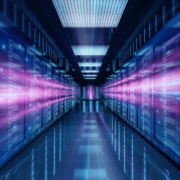Tier III Certified Facilities Prove Critical to Norwegian Colo’s Client Appeal
Green Mountain melds sustainability, reliability, competitive pricing, and independent certifications to attract international colo customers
By Kevin Heslin
Green Mountain operates two unique colo facilities in Norway, having a total potential capacity of several hundred megawatts. Though each facility has its own strengths, both embody the company’s commitment to providing secure, high-quality service in an energy efficient and sustainable manner. CEO Knut Molaug and Chief Sales Officer Petter Tømmeraas recently took time to explain how Green Mountain views the relationship between cost, quality, and sustainability.
Tell our readers about Green Mountain.
KM: Green Mountain focuses on the high-end data center market, including banking/finance, oil and gas, and other industries requiring high availability and high quality services.
PT: IT and cloud are also very big customer segments. We think the US and European markets are the biggest for us, but we also see some Asian companies moving into Europe that are really keen on having high-quality data centers in the area.
KM: Green Mountain Data Centers operates two data centers in Norway. Data Center 1 in Stavanger began operation in 2013 and is located in a former underground NATO ammunition storage facility inside a mountain on the west coast. Data Center 2, a more traditional facility, is located in Telemark, which is in the middle of Norway.
Today DC1-Stavanger is a high security colocation data center housing 13,600 square meter facility (m2) of customer space. The infrastructure can support up to 26 megawatts of IT load today. The main data center comprises three two-story concrete buildings built inside the mountain, with power densities ranging from 2-6 kW/m2, but the facility can support up to 20 kW/m2. NATO put a lot of money into creating their facilities inside the mountain, which probably saved us 1 billion Kroners ($US 150 million).
DC2-Telemark is located in a historic region of Norway and was built on a brownfield site with a 10-MW supply initially available. The first phase is a fully operationa1 10-MW Tier lll Certified Facility, with four new buildings and up to 25 MW total capacity planned. This site could support even larger facilities if the need arises.
Green Mountain focuses a lot on being green and environmentally friendly, so we use 100% renewable energy in both data centers.
How do the unique features of the data centers affect their performance?
KM: Besides being located in a mountain, DC1 has a unique cooling system. We use the fjords for cooling year round, which gives us 8°C (46 °F) water for cooling. The cooling solution (including cooling station, chilled water pipework and pumps) is fully duplicated, providing an N+N solution. Because there are few moving parts (circulating pumps) the solution is extremely robust and reliable. In-row cooling is installed to client specification using Hot Aisle technology.
We use only 1 kilowatt of power to produce 100 kilowatts of cooling. So the data center is extremely energy efficient. In addition, we are connected to three independent power supplies, so DC1 has extremely robust power.
DC2 probably has the most robust power supply in Europe. We have five independent hydropower plants within a few kilometers of the site, and the two closest are just a few hundred meters away.
How do you define high quality?
PT: High quality means Uptime Institute Tier Certification. We are not only saying we have very good data centers. We’ve gone through a lot of testing so we are able to back it up, and the Uptime Institute Tier Standard is the only standard worldwide that certifies data center infrastructure to a certain quality. We’re really strong on certifications because we don’t only want to tell our customers that we have good quality, we want to prove it. Plus we want the kinds of customers who demand proof. As a result, both our facilities are Tier III Certified.
Please talk about the factors that went into deciding to obtain Tier Certification.
KM: We have focused on high-end clients that require 100% uptime and are running high-availability solutions. Operations for this type of company generally require documented infrastructure.
The Tier III term is used a lot, but most companies can’t back it up. Having been through testing ourselves, we know that most companies that haven’t been certified don’t have a Tier III facility, no matter what they claim. When we talk to important clients, they see that as well.
What was the on-site experience like?
PT: When the Uptime Institute team was on site, we could tell that Certification was a quality process with quality people who knew what they were doing. Certification also helped us document our processes because of all the testing routines and scenarios. As a result, we know we have processes and procedures for all the thinkable and unthinkable scenarios and that would have been hard to do without this process.
Why do you call these data centers green?
KM: First of all we use only renewable energy. Of course that is easy in Norway because all the power is renewable. In addition we use very little of it, with the fjords as a cooling media. We also built the data centers using the most efficient equipment, even though we often paid more for it.
PT: Green Mountain is committed to operate in a sustainable way and this reflects in everything we do. The good thing about operating in such a way is that our customers benefit from this financially. As we bill power cost based on consumption of power, the more energy efficient we operate the smaller the bill to our customer. When we tell these companies that they can even save money going for our sustainable solutions this makes their decision easier.
More and more customers require that their new data center solutions are sustainable, but we still see that price is a key driver for most major customers. The combination of having very sustainable solutions and being very competitive on price is the best way of driving sustainability further into the mind of our customers.
All our clients reduce their carbon footprint when they move into our data centers and stop using their old and inefficient data centers.
We have a few major financial customers that have put forward very strict targets with regards to sustainability and that have found us to be the supplier that best meets these requirements.
KM: And, of course, making use of an already built facility was also part of the green strategy.
How does your cost structure help you win clients?
PT: It’s important, but it’s not the only important factor. Security and the quality we can offer are just as important, and that we can offer them with competitive pricing is very important.
Were there clients who were attracted to your green strategy?
PT: Several of them, but the decisive factor for customers is rarely only one factor. We offer a combination between a really, really competitive offering and a high quality level. We are a really, really sustainable and green solution. To be able to offer that at competitive price is quite unique because often people think they have to pay more to get a sustainable green solution.
Are any of your targeted segments more attracted to sustainability solutions?
PT: Several of the international system integrators really like the combination. They want a sustainable solution, but they want the competitive offering. When they get both, it’s a no-brainer for them.
How does your sustainability/energy efficiency program affect your reliability? Do potential clients have any concerns about this? Do any require sustainability?
PT: Our programs do not affect our reliability in any way. We have chosen only to implement solutions that do not harm our ability to deliver the quality we promise to our customers. We have never experienced one second of SLA breakage on any customer in any of our data centers. In fact, some of our most sustainable solutions, like the cooling system based on cold sea water, increase our reliability as it takes down the risk of failure considerably compared to regular cooling systems. We have not experienced any concerns about these solutions.
Has Tier Certification proven critical in any of your client’s decisions?
PT: Tier certification has proved critical in many of our client`s decision to move to Green Mountain. We see a shift in the market to require Tier certification, whereas it used to be more in the form of asking for Tier compliance, that anyone could claim without having to prove it. We think the future of quality data center providers will be to certify all their data centers.
Any customer with mission critical data should require their supplier/s to be Tier certified. At the moment this is the only way for a customer to secure that their data center is built and operated in the way it should in order to secure the quality that the customer needs.
Are there other factors that set you apart?
PT: Operational excellence. We have an operational team that excels every time. They deliver to the customers a lot more than expected every time, and we have customers that are extremely happy with their deliveries from us. I hear that from customers all the time, and that’s mainly because our operations team do a phenomenal job.
Uptime Institute testing criteria were very comprehensive and helped us develop our operational procedures to an even higher level as some of the scenarios created during the certification testing were used as a basis for new operational procedures and new tests that we now perform as part of our normal operating procedures.
Green Mountain definitely benefitted from the Tier process in a number of other ways, including training gave us useful input to improve our own management and operational procedures.
What did you do to develop this team?
KM: When we decided to focus on high-end clients, we knew that we needed high-end experience and expertise and knowledge on the ops side, so we focused on that when recruiting as well as building a culture inside the company that focused on delivering high quality the first time every time.
We recruited people with knowledge of how to operate critical environments, and we tasked them with developing those procedures and operational elements as a part of their efforts, and they have successfully done so.
PT: And the owners made the resources available so that they could spend the resources—both financial and staff-hour wise to create the quality we wanted. We also have a very good management system, so management has good knowledge of what’s happening, so if we have an issue it will be very visible.
KM: We also have high-end equipment and tools to measure and monitor everything inside the data center as well as operational tools to make sure we can handle any issue and deliver on our promises.
Kevin Heslin is Chief Editor and Director of Ancillary Projects at Uptime Institute. In these roles, he supports Uptime Institute communications and education efforts. Previously, he served as an editor at BNP Media, where he founded Mission Critical, a commercial publication dedicated to data center and backup power professionals. He also served as editor at New York Construction News and CEE and was the editor of LD+A and JIES at the IESNA. In addition, Heslin served as communications manager at the Lighting Research Center of Rensselaer Polytechnic Institute. He earned the B.A. in Journalism from Fordham University in 1981 and a B.S. in Technical Communications from Rensselaer Polytechnic Institute in 2000.





 Uptime Institute, 2019
Uptime Institute, 2019 2020
2020

 UI 2020
UI 2020 2020
2020